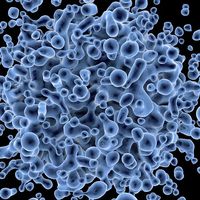Unintended Effects of Anti-Cancer Drugs
Drug development is a huge component of healthcare research that continues to grow, however, about 90% of drugs generated fail to make it to clinical trials. Drugs designed to target cancer fail due to many different obstacles including the tumor microenvironment (TME), which is the area surrounding the tumor. The TME is comprised of multiple cells generated to suppress the immune system and allow the tumor to grow. Since there are many mechanisms involved that makeup the TME, it is difficult to prescribe patients anti-cancer drugs that completely kill the tumor. Often a combination therapies are needed, but doctors run the risk of adverse side effects in patients due to toxicity of too many drugs.
Recently, a study published in eLife from Dr. Jennifer Gerton at the Stowers Institute for Medical Research in Kansas City, Missouri reported one critical reason why patients may experience unexpected side effects on the cellular level.
A common cellular proce
ss is the generation of proteins known as ribosomes. These proteins are responsible for the generation of all cellular proteins and are necessary for a cell’s survival. After screening over 1,000 existing anti-cancer drugs, the study found that the anti-cancer drugs target the nucleolus, the primary organelle in the cell that makes ribosomes. In cancer cells, this process is upregulated due to their rapid proliferative nature. The appearance of the nucleolus can vary greatly, and this serves as a key indicator of cell stress to researchers when observing cells. Therefore, it was a great organelle to detect cell stress when they administered these anti-cancer drugs.
Gerton and colleagues observed the nucleolus in cancer cells after treatment with anti-cancer drugs to determine how the drugs were affecting the cells. They categorized the results based on the nucleolus’ appearance. They also generated a classification system based on their work to further help other researchers classify the effects of drugs on cancer cells based on the nucleolus appearance.
It is common for different anti-cancer drugs to affect other things in the cancer cells besides the nucleolus. Additionally, ribosomal production can generate nucleolar stress at different states, which make measuring nucleolar stress through morphological or physical stress much more difficult. For example, different cells can have more than one nucleolus at different sizes and shapes. It is difficult to find a single parameter to clear decipher what a “normal” nucleolus is and whether it is under stress. Gerton and colleagues tried to develop a “nucleolar normality score” to try and standardize the process.
Through the classification process, the researchers found a class of enzymes, a particular protein that breaks down molecules, which destroys the nucleolus almost completely when inhibited. The enzyme identified are part of a broader family known as cyclin-dependent kinases. Many drugs use these enzymes as anti-cancer drugs. The issue is that these drugs were designed for a different purpose but are targeting the nucleolus as well as a separate desired pathway.
The research reported by Gerton and others highlight the identification of how some anti-cancer drugs work can better inform the science community in developing therapeutic treatments. Additionally, this research is critical to the understanding of drug administration and inform physician when and when not to prescribe anti-cancer medications.
Study, eLife, Jennifer Gerton, Stowers Institute for Medical Research








